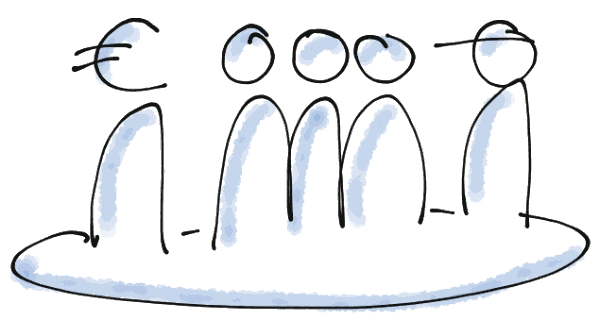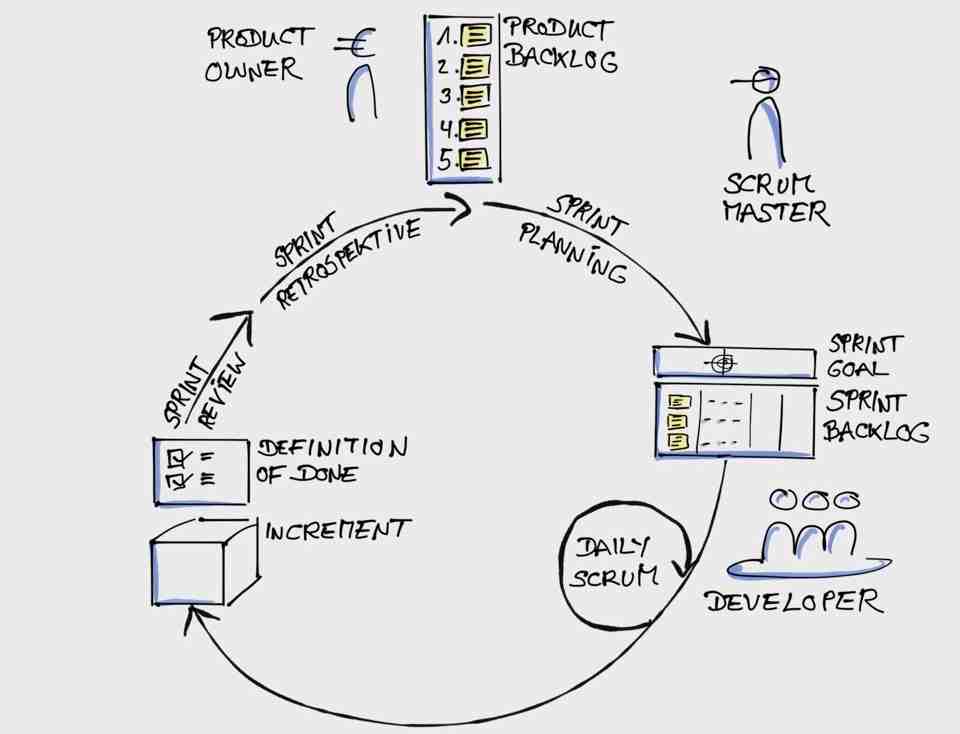Agile frameworks
Scrum: Framework for development with agile teams
"Scrum is a framework for agile teamwork." These or similar explanations can be found everywhere online. To explain what Scrum is really about and how you, your team and your company can benefit from it, we will give a concrete explanation and limit ourselves to the most important terms.
What is Scrum and how does it work?
Imagine you want to renovate your house while continuing to live in it. You probably won't tackle all the rooms at once, but will finish one room the first week and the next the following week. Until finally the whole house is finished and all rooms are usable. Scrum works in a similar way: In small, evenly defined time units ("sprints") of a maximum of four weeks, the teams work on small, defined parts of the product ("increments") that are potentially usable at the end of the sprint. The advantages of this approach: you get early and regular (partial) deliveries and can react quickly to changing requirements. You do not face the impossible challenge of having to plan a project in detail over several years in advance.
Scrum is simple to understand.
In Scrum, the focus is on your customer and his wishes. In the agile context, his wish list is called a "product backlog". In it, his wishes and requirements are described and sorted according to importance (ROI, benefit, etc.). At the beginning of each sprint, the development team "pulls" as many Product Backlog entries - according to priority, of course - as it believes it can realistically implement in the coming sprint. This continuously creates potentially usable product parts ("increments"). These are reviewed by your customer in a joint round ("Sprint Review"), checked for fulfillment of the benefits and the feedback is recorded. On this basis, you make decisions for the further course of the project. And because Scrum is not only about the product, but also about the people and their cooperation, the Sprint ends with a Sprint Retrospective. Here, the team reflects on its working methods, talks about obstacles and agrees on measures to eliminate them.
The 3-5-3 System: The Elements of Scrum
Scrum defines only a few cornerstones of the procedure and is therefore referred to as a framework. At its core are: three roles or responsibilities, five events and three result types ("artifacts").
One team focused with 3 responsibilities on a common delivery
The product owner is responsible for the requirements for the features of a product and for its ROI. He arranges the Product Backlog entries and steers the development in the right direction.

-
The Scrum Master ensures that the team can work productively and "protects" the agile approach. He makes sure that everyone understands the rules of Scrum and works according to them, and he helps the team to remove obstacles.
-
The developers work in a self-organized manner and are responsible for achieving the sprint goal. The Scrum Team - Product Owner, Scrum Master and Development Team - manages their work in the Sprint together and independently.
The five events in Scrum
In the order of passing the events within a sprint:
- Sprint Planning: In Sprint Planning, the Scrum Team - consisting of Product
 Owner, Scrum Master and developers - details the work to be done in the next Sprint and determines the requirements that can be implemented in the next Sprint (typically between two and four weeks).
Owner, Scrum Master and developers - details the work to be done in the next Sprint and determines the requirements that can be implemented in the next Sprint (typically between two and four weeks). - Daily Scrum: The daily Scrum, moderated by the Scrum Master and lasting a maximum of 15 minutes, is about enabling progress towards the Sprint goal and solving problems as a team. Each team member answers e.g. the questions: "What did I do yesterday?", "What am I doing today?" and "What is hindering me?"
- Sprint Review: The Sprint Review is about presenting increments - potentially usable parts of the product - and gathering feedback from customers and users in order to optimize the product and adapt it to their needs.
- Sprint Retrospective: In the Sprint Retrospective, the team looks at the way it worked in the Sprint and defines measures to improve its work in the next Sprint;
- Product Backlog Refinement: The Product Backlog Refinement is actually not a classic Scrum event, but a continuous activity. This includes updating the entries in the Product Backlog and adding and ordering necessary details and estimates.

The three artifacts in Scrum
-
The Product Backlog is a list of customer requirements - which the Product Owner prioritizes by importance.
-
The Sprint Backlog contains all Product Backlog entries (customer requirements) that the development team will implement in the next Sprint.
-
The product increment is the partial product that contains the completed product backlog entries - including all previous and new functionalities.
The valid framework for Scrum: The Scrum Guide
The recognized framework for the description and further development of Scrum is the Scrum Guide in the current version of 2020. The can also be found here in browser format: Scrum in the browser
The prerequisite for the success of Scrum: an agile work culture
The decisive success factor for Scrum is the work culture behind it.
-
Part of this work culture is delivering results early, inspecting and adapting. In a complex environment, it takes concrete experience and results to determine if you are on the right track. This allows them to inspect and adjust results based on facts. The willingness for the necessary transparency and the constructive handling of feedback is a part of the work culture that is necessary in the agile work environment, but often differs from more traditional work cultures.
-
Another important principle of Scrum is self-management. In a volatile environment and in a world where development cycles are cut in half every two years, speed is critical. Self-management without long approval processes is one of the most effective ways to achieve this.
-
These principles are supported by an attitude based on the values of "openness", "respect", "courage", "commitment" and "focus".
In sum, these principles and the values are the work culture that really make up Scrum. In companies that live this work culture, Scrum very quickly leads to better results. However, the introduction of Scrum often means a cultural change for teams and their environment. And this cultural change takes a little time.
Scrum - easy to say, but hard to learn.
Scrum is actually easy to understand with the 3-5-3 system (3 roles/responsibilities, 5 events, 3 artifacts), and used correctly it is incredibly effective. So why doesn't everyone work with it? Quite simply, because the work culture behind Scrum, while an excellent fit for a complex world, is relatively demanding. And because self-organization does not fall from the sky, but must first be learned and allowed. Furthermore, the cultural change behind Scrum needs time and the attention of the management, especially at the beginning. Don't be deterred by this, because we are happy to support you even before the first agile steps are taken to find or create the best possible setting for a successful Scrum introduction. Just contact us, we are looking forward to talking to you.
How do I get started with Scrum?
The best way is to experience Scrum. You can do that in our Scrum Master or Product Owner trainings. After that we recommend Scrum Coaching - because theory is one thing, daily practice is another.
If the big goal of an agile organization is already in focus, then a Agile Transformation and the coaching of the teams can be put into a superior framework right away.
Contact us or make an appointment directly. We are Timo Foegen, Yvonne Fischer, Tina Eisoldt, Daniel Votta and Lutz Koch.
"We look forward to talking to you about your requirements and finding the perfect support for you."
The advantage of Scrum: the goals in focus.
- First things first: If implemented correctly and consistently, Scrum leads to more benefits with less effort. Sounds too good to be true, but it is. By consistently organizing the product backlog on the basis of a cost-benefit ratio, a team always implements the most important requirements first, which bring a high benefit. This way you get good results quickly and early.
- Continuous delivery: By regularly and predictably completing increments at a fixed rate, you can delivercontinuously and test "real" product parts.
- Fast reaction: In addition, the short sprints give you the opportunity to always react very quickly (within a maximum of four weeks) to changing requirements and make changes. This way you not only reduce the risk of failure, but also the waste of resources.
- Continuous improvement: The regular reviews and retrospectives ensure constant quality improvement and process optimization.
- Practiced way of working: And with the fixed framework, you and all parties involved know at any time what the status is and what needs to be done.
- Focus on the essentials: Scrum also helps keep the entire team focused on the next set of goals. Planning techniques are reduced to the essentials in Scrum, but they are all the more important for that. This is because they serve only one purpose: to keep the goals and their achievement in focus and to identify and correct deviations as early as possible. The team does this daily with regard to the sprint goal and - thinking in terms of longer periods of time - regularly with regard to the milestones and the product vision.
Scrum Master
Do you want a team to pick up speed quickly? But you don't have a Scrum Master right now? We can help you.
Our Scrum trainings
From Scrum Master or Product Owner to Scrum Professional: We offer the Scrum Alliance training series with certificate.
Scrum Browser
Click here for our Scrum Browser
Certified Scrum Master (CSM) Training
In this certified training you will learn about Scrum and the tasks of a Scrum Master.
Certified Scrum Product Owner (CSPO) Training
In this certified training you will learn about Scrum and the tasks of a Product Owner.
Scrum consultation hour
Do you have questions about Scrum or agility? Our colleague Anna Rudat offers a Scrum consultation hour every second Tuesday.
wibas Scrum Poster
The importance of team phases for Scrum Masters
Tuckmann's team phases can help you develop your team. Read here how.
Scrum Compact
Scrum for your pocket. For smart answers if you get asked smart questions.
The Ultimate Scrum Guide
Scrum explained in detail in one book. With great double pages that are self-contained.
Your expert for Scrum:
Sascha Geßler
wibas GmbH
Sascha Geßler
Otto-Hesse-Str. 19B
64293 Darmstadt
+49 6151 503349-0
